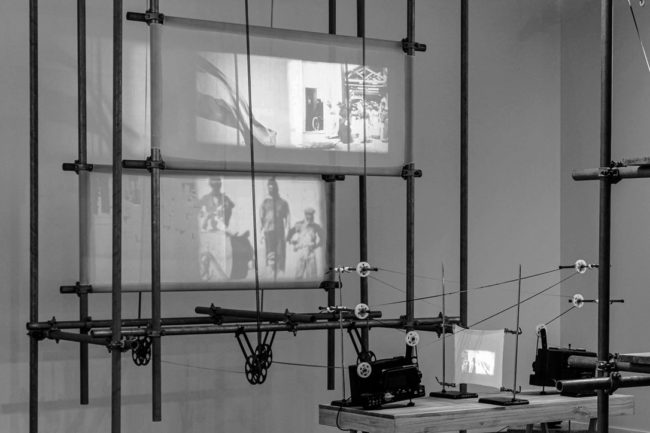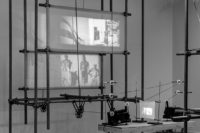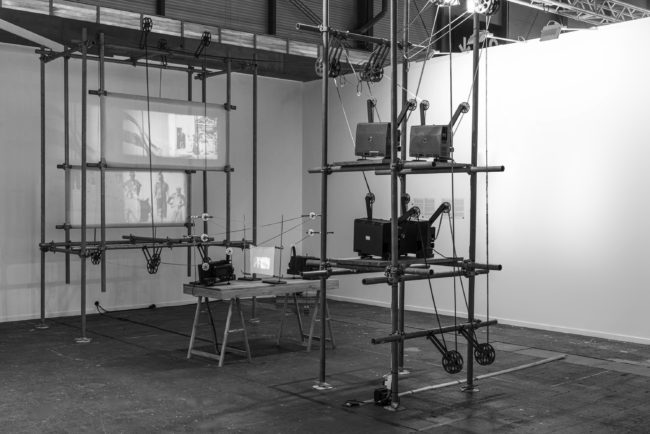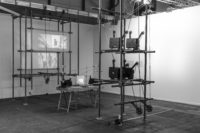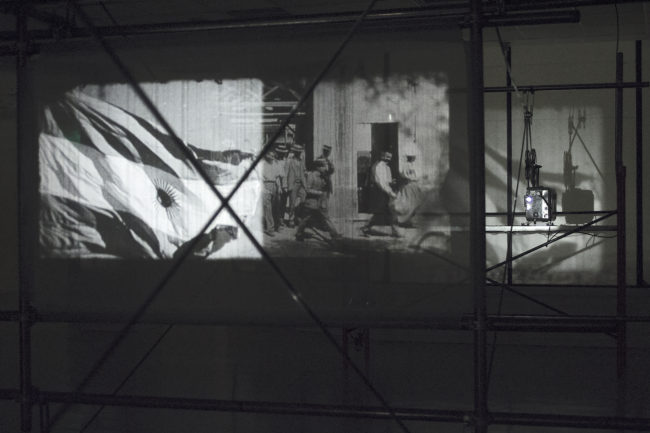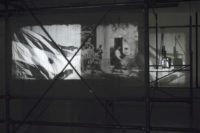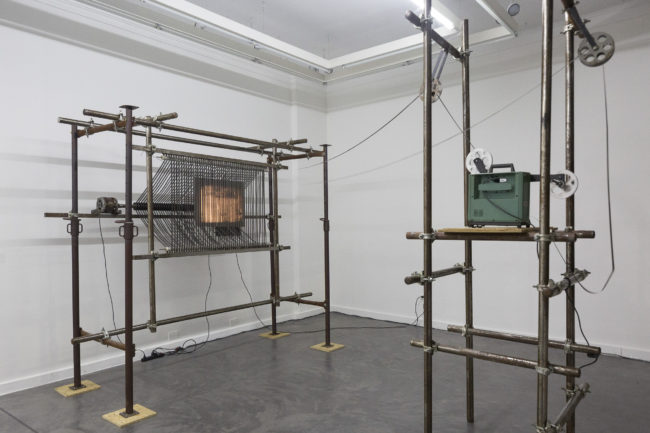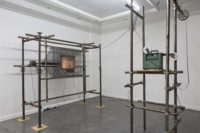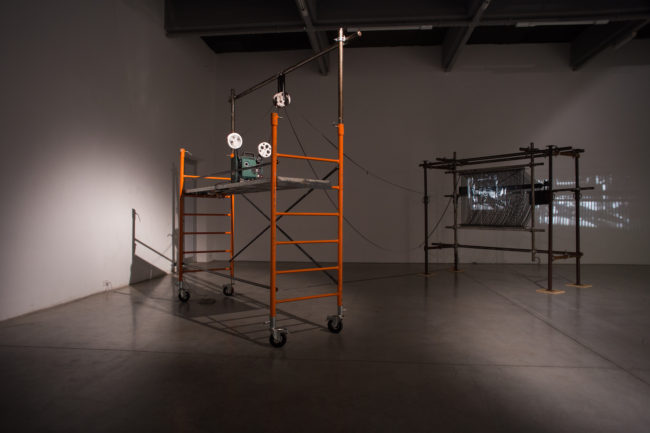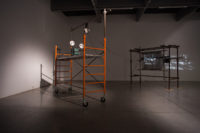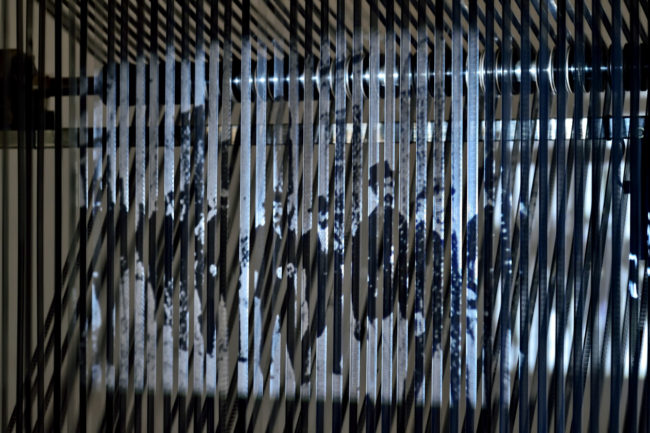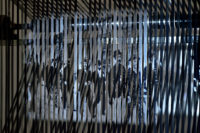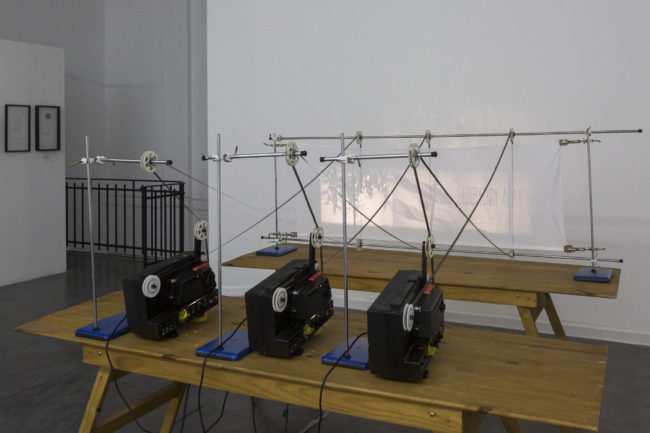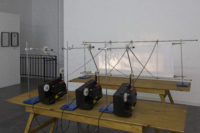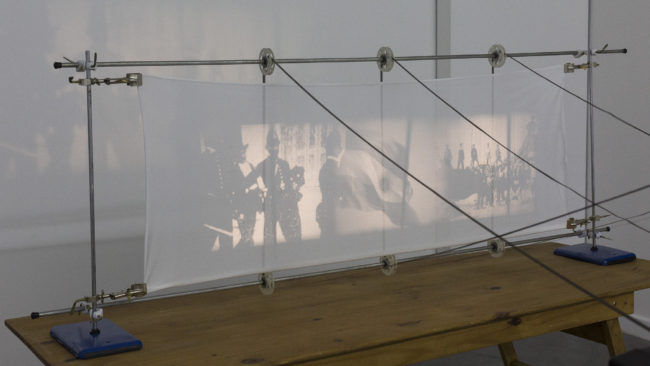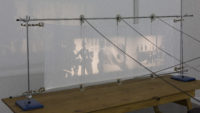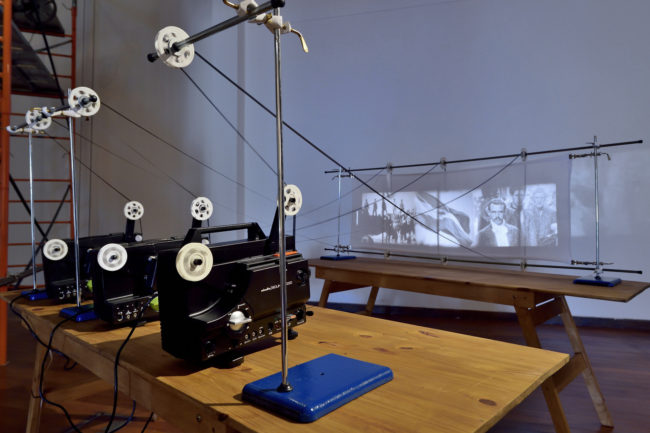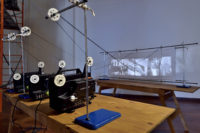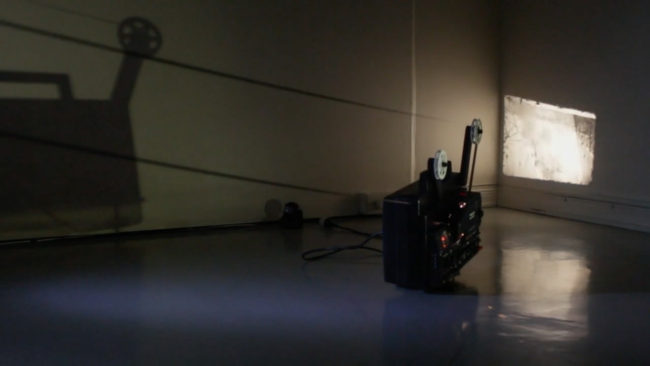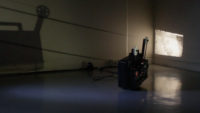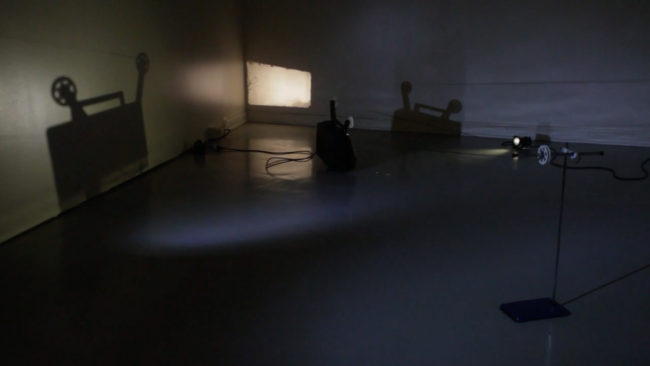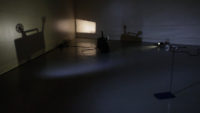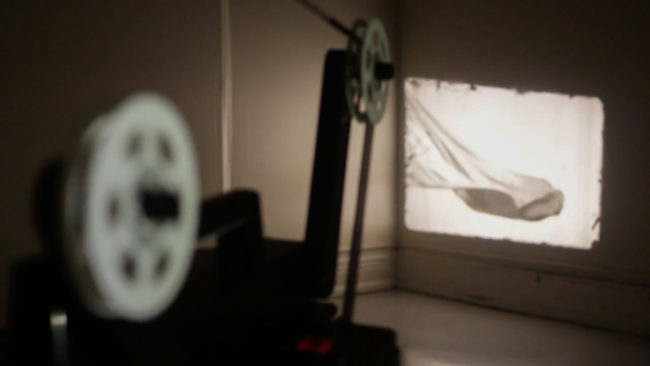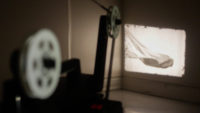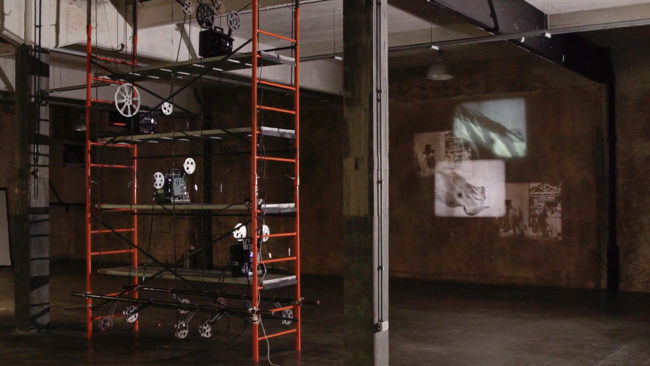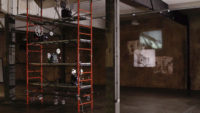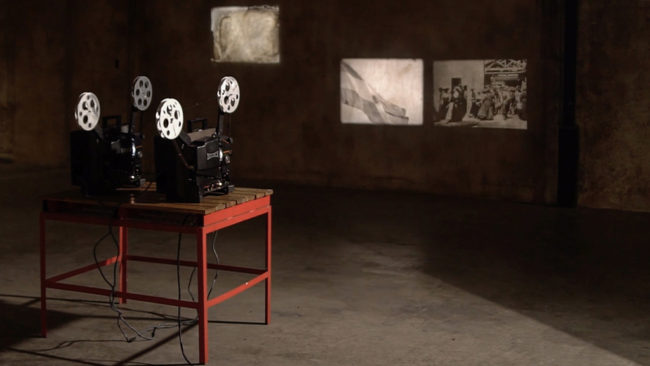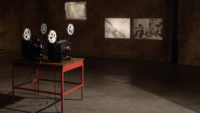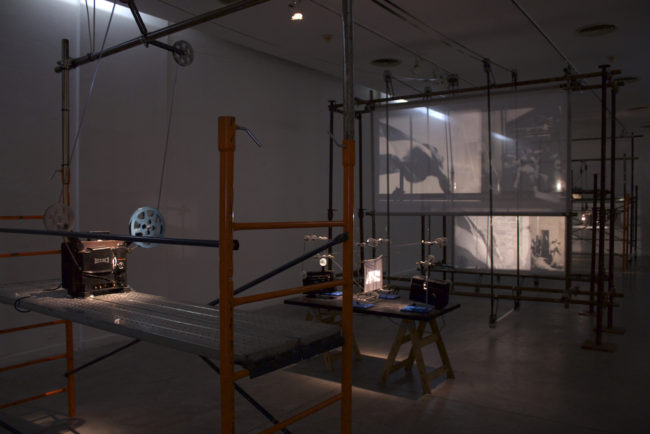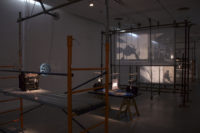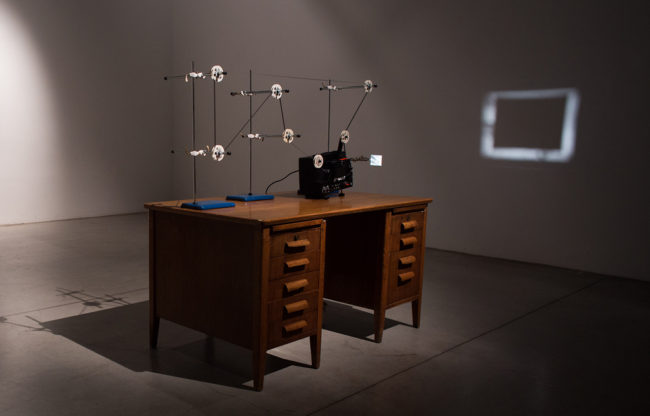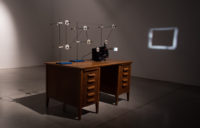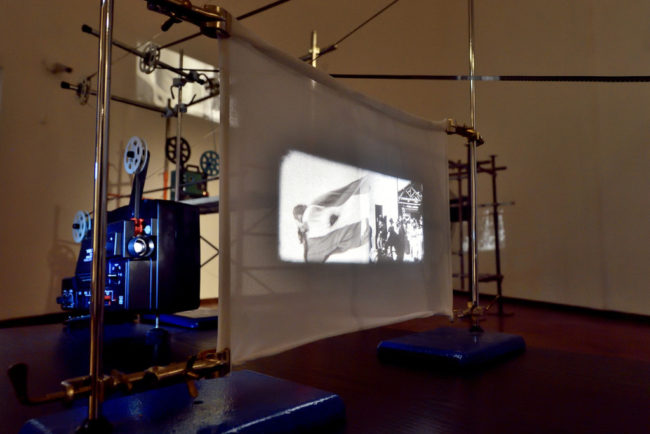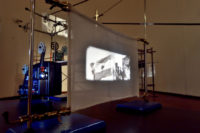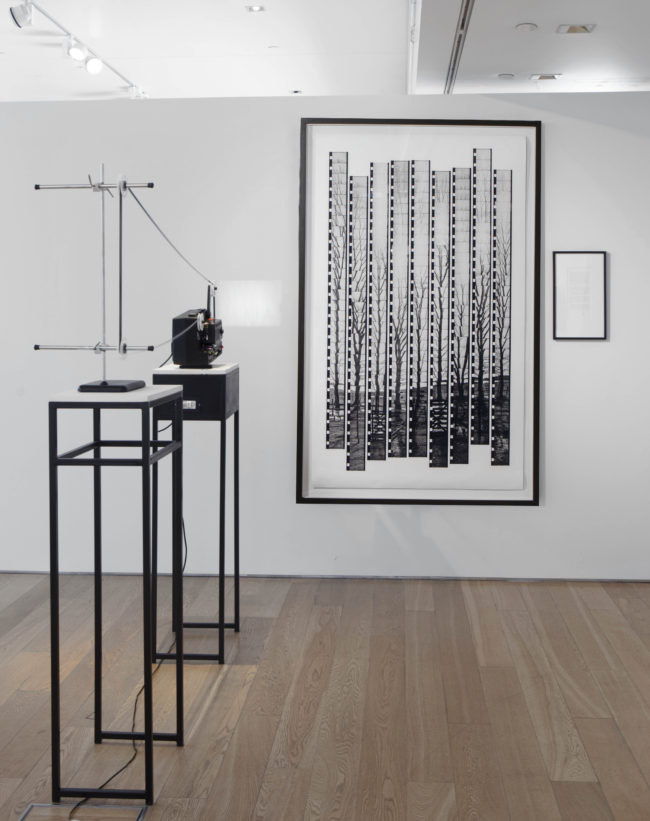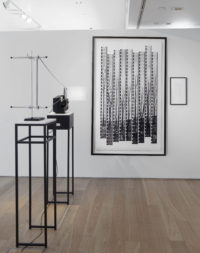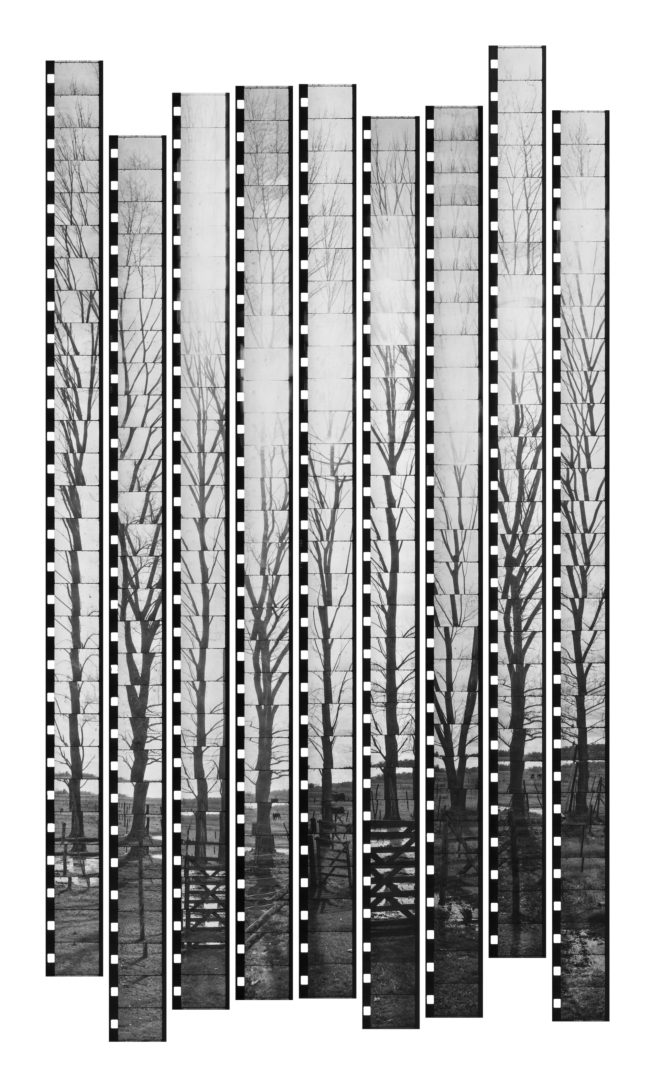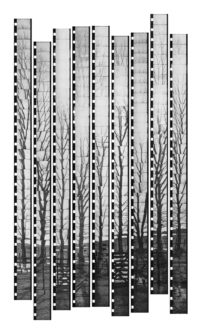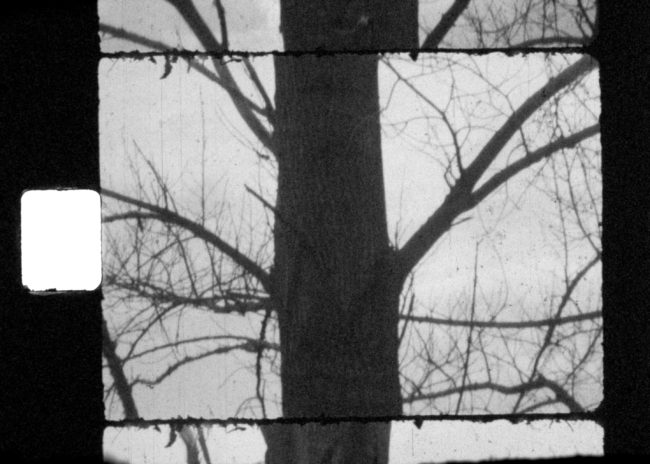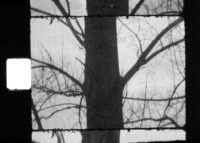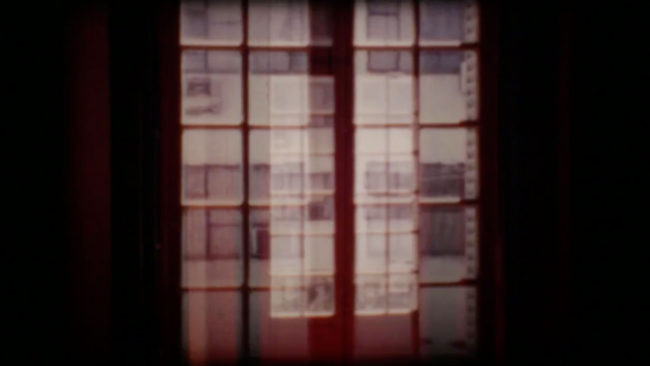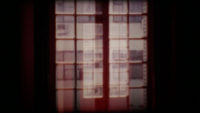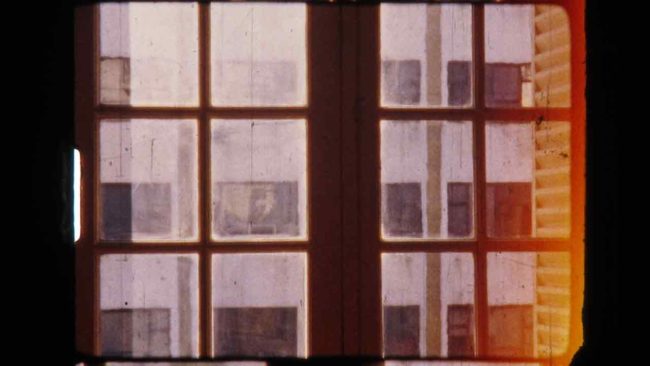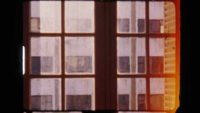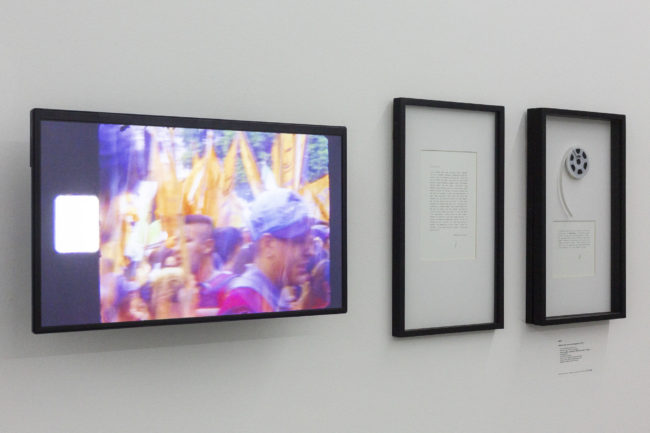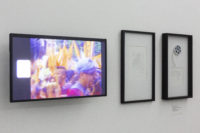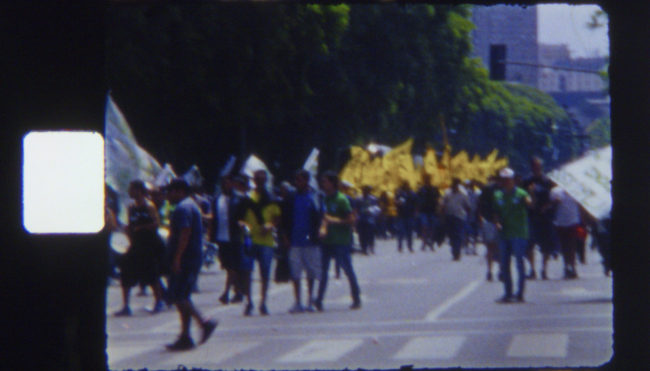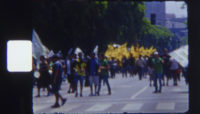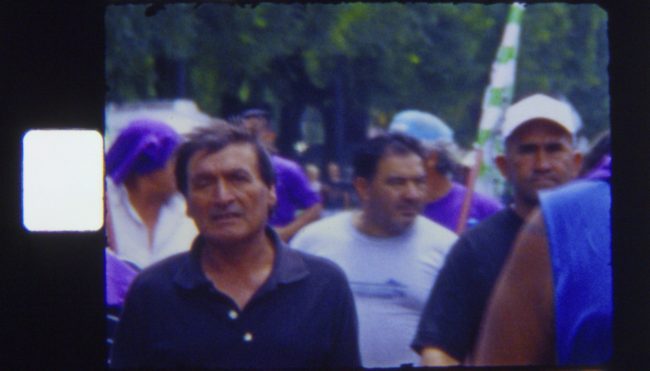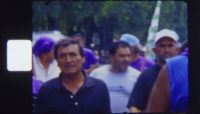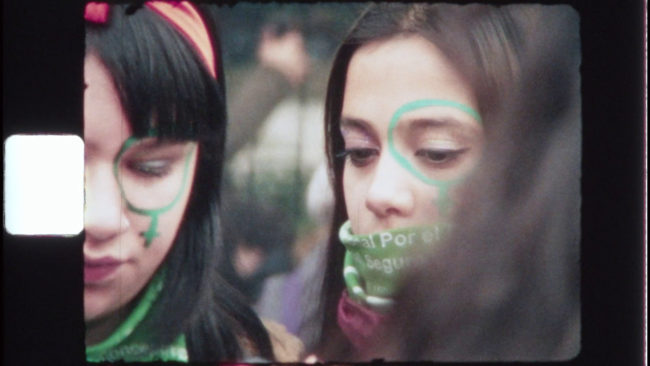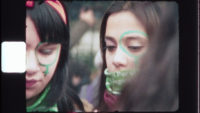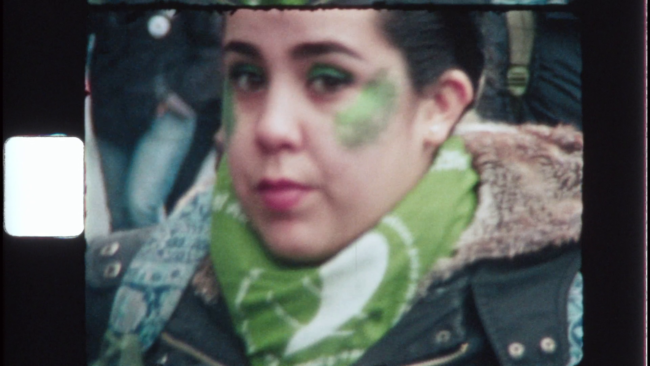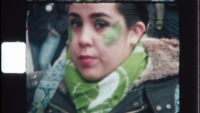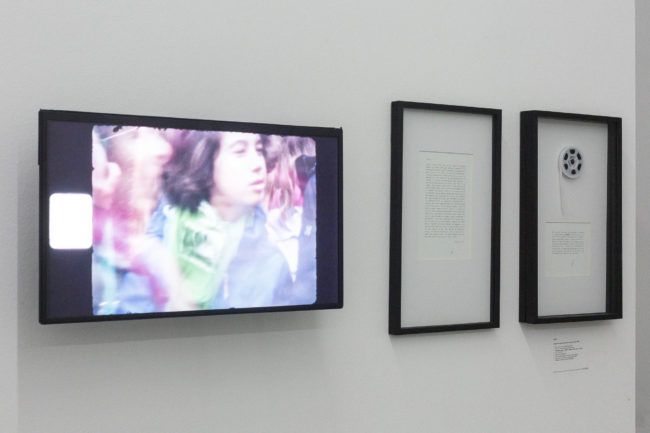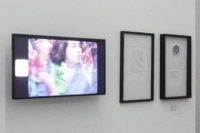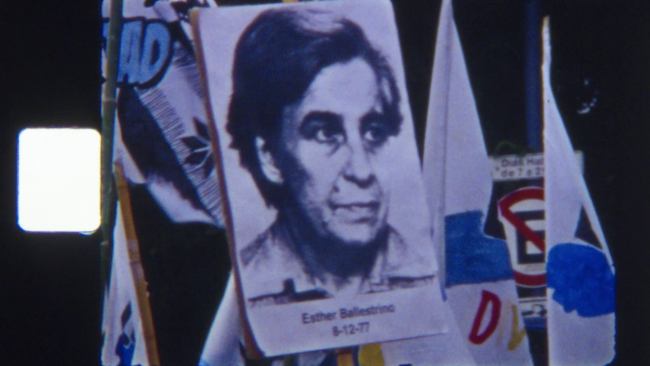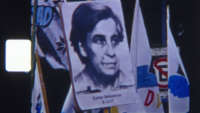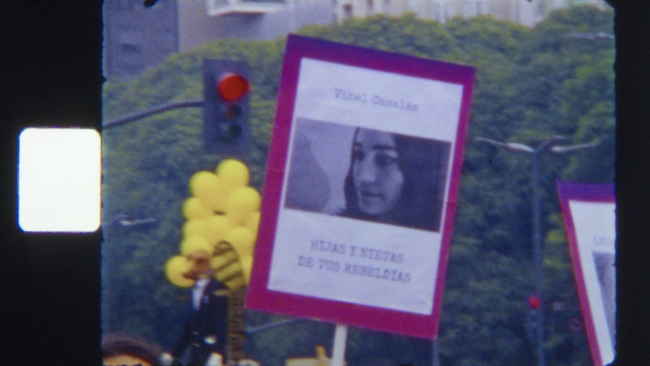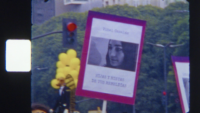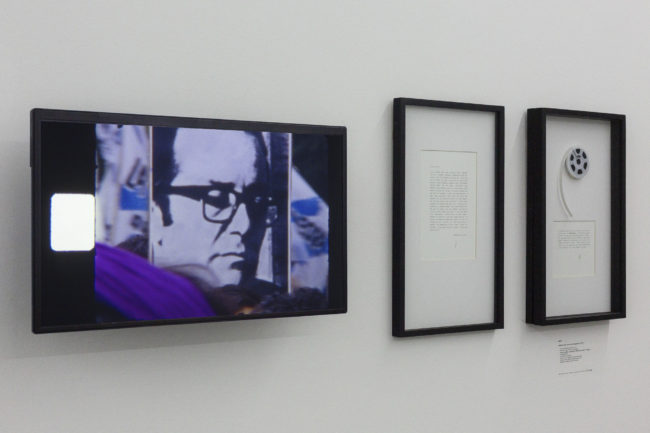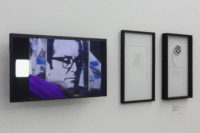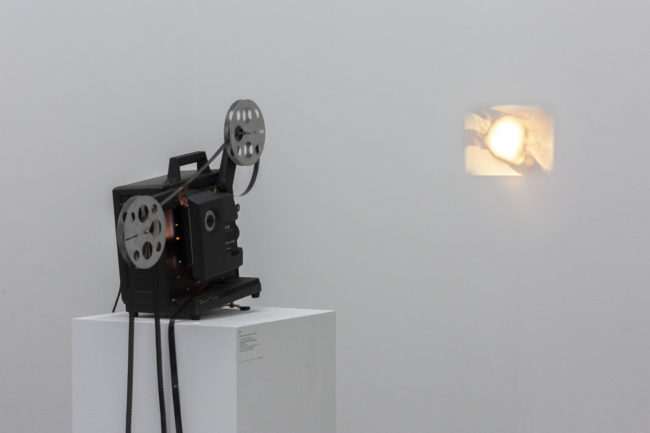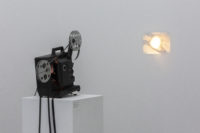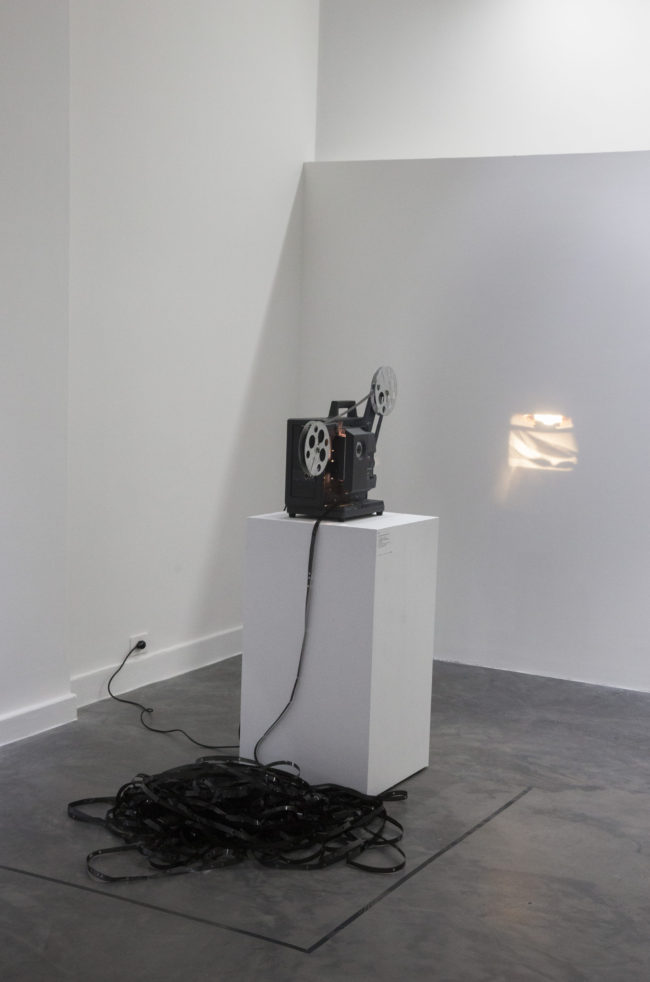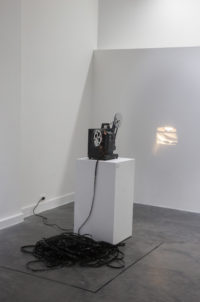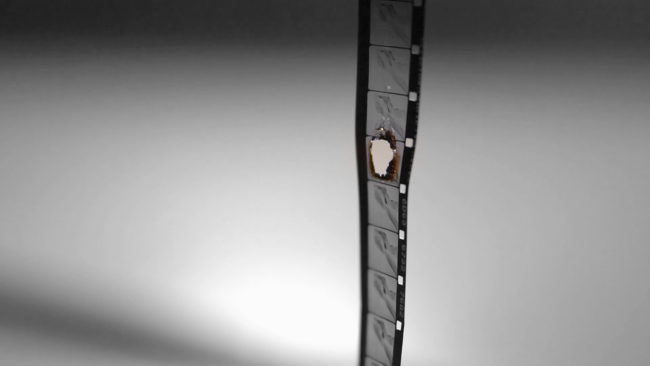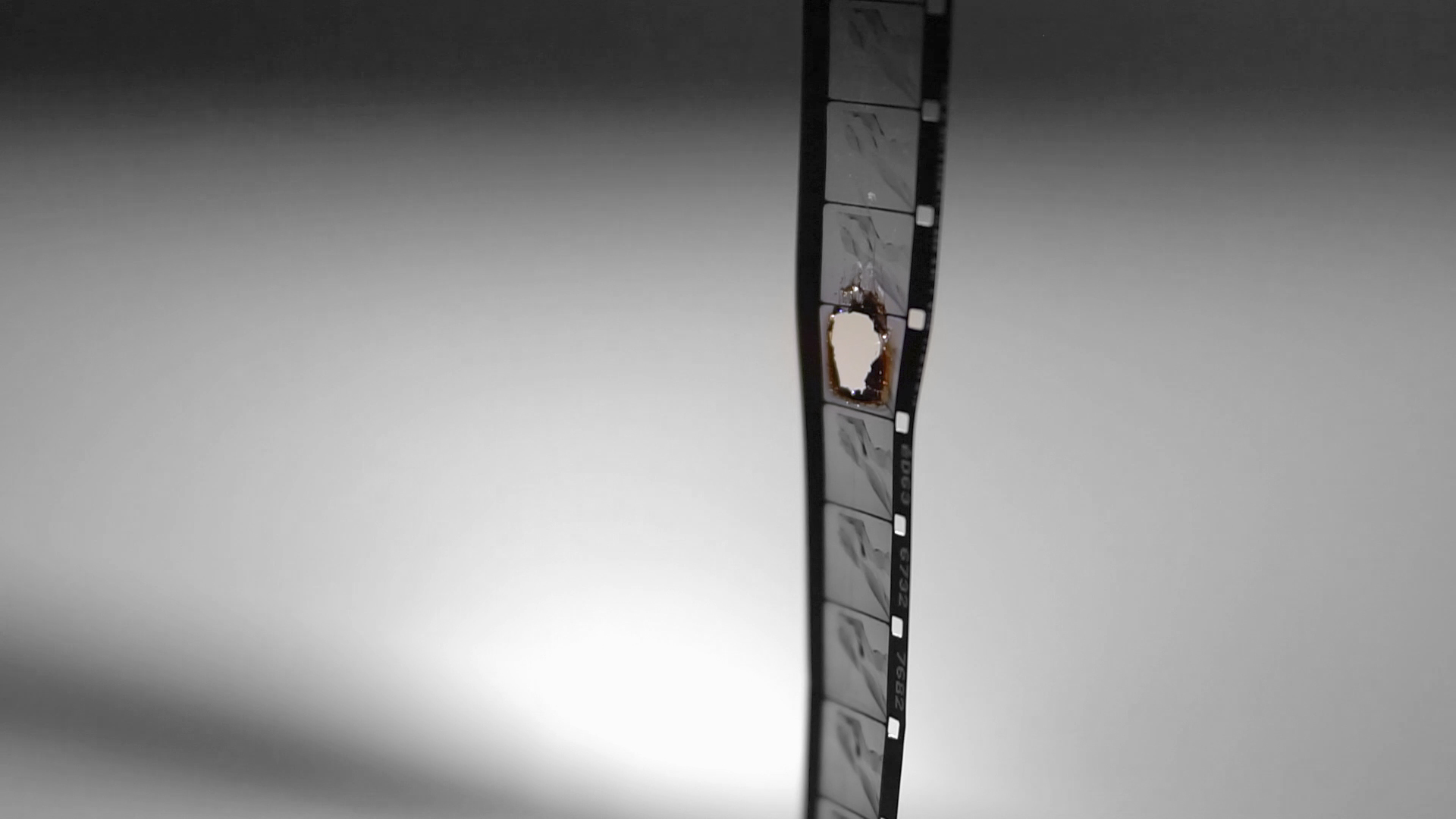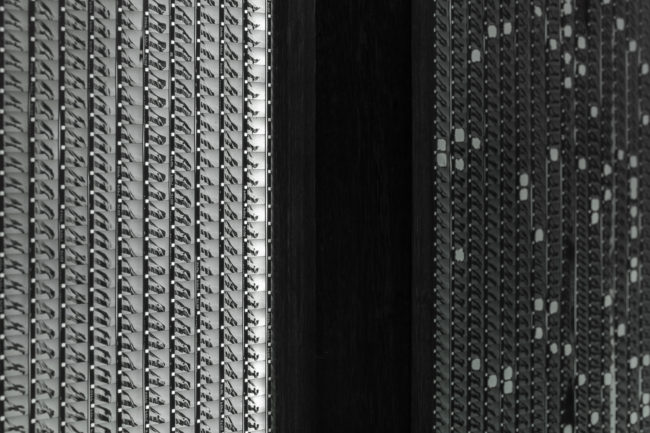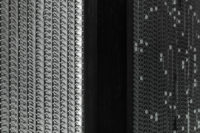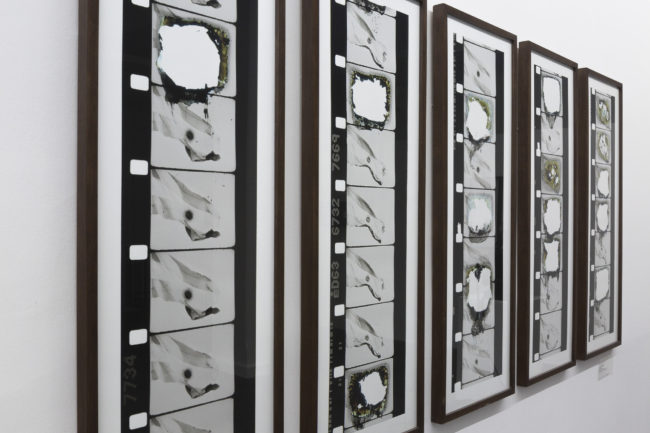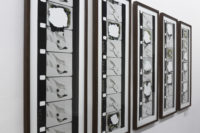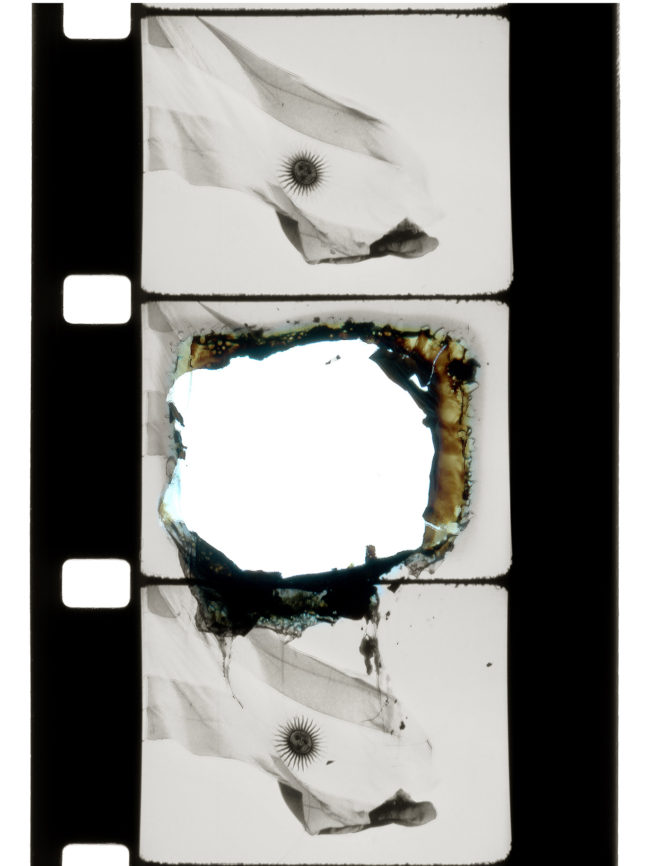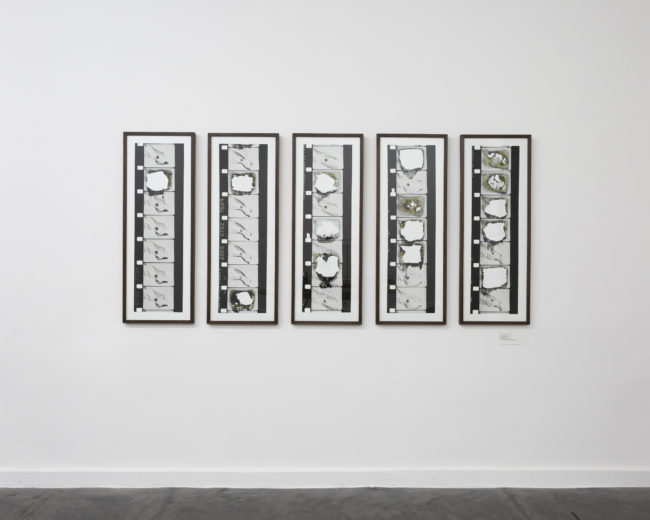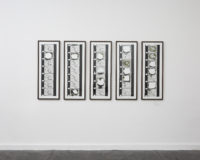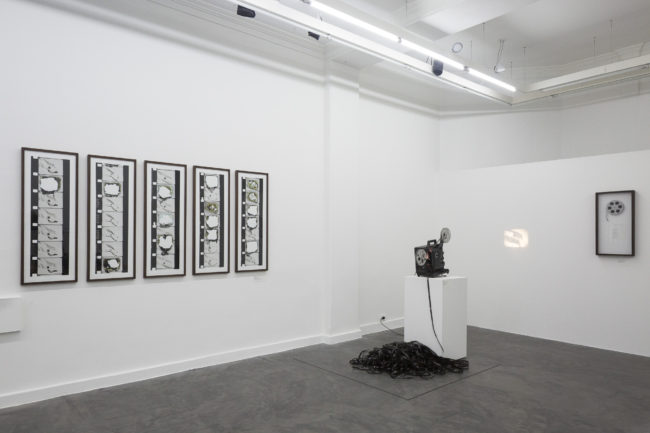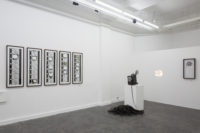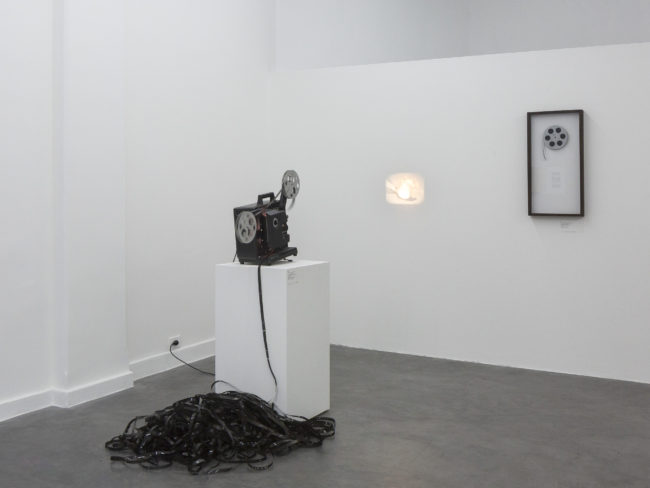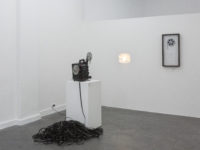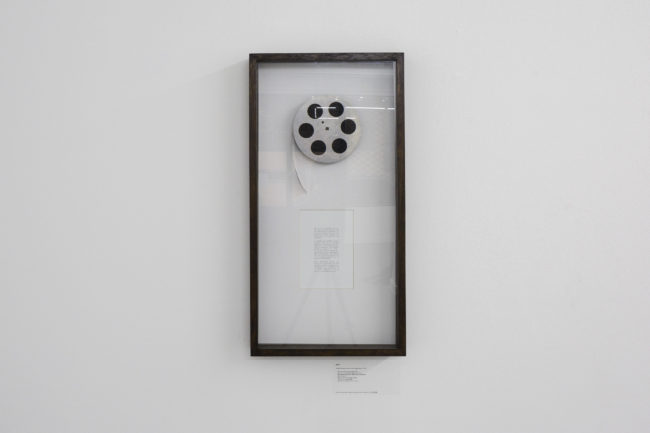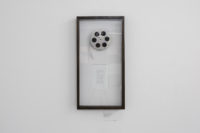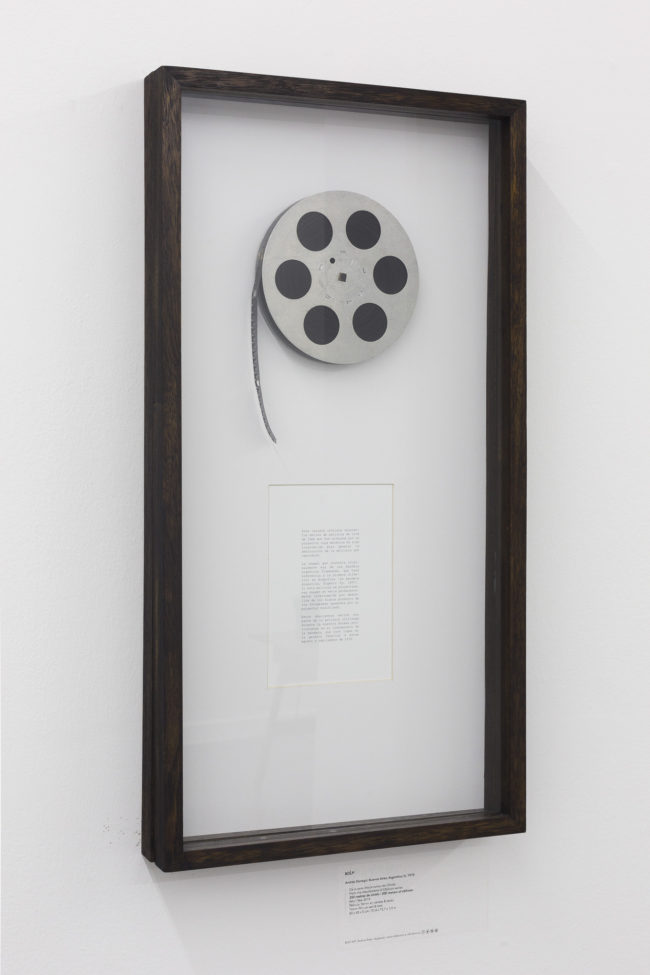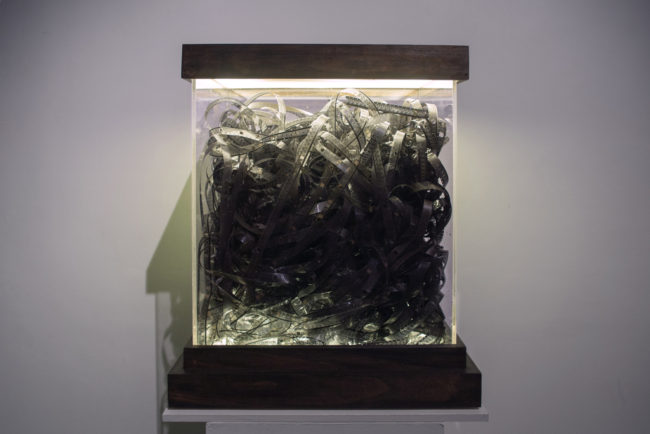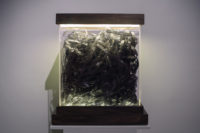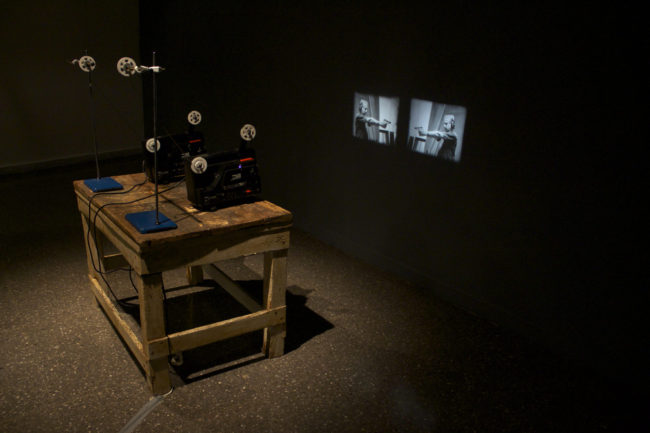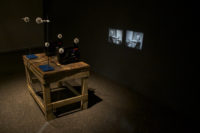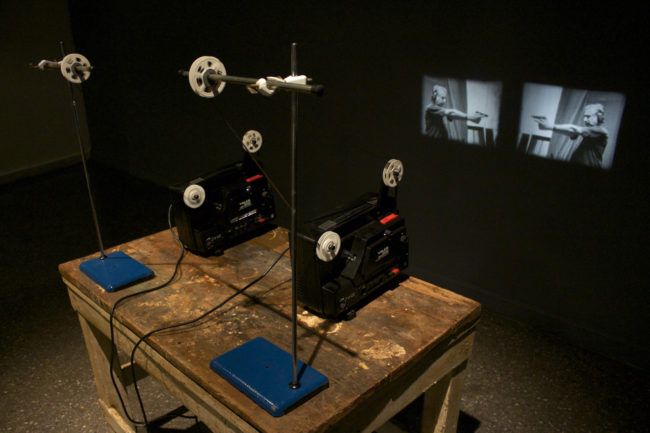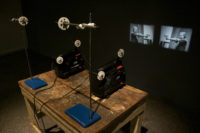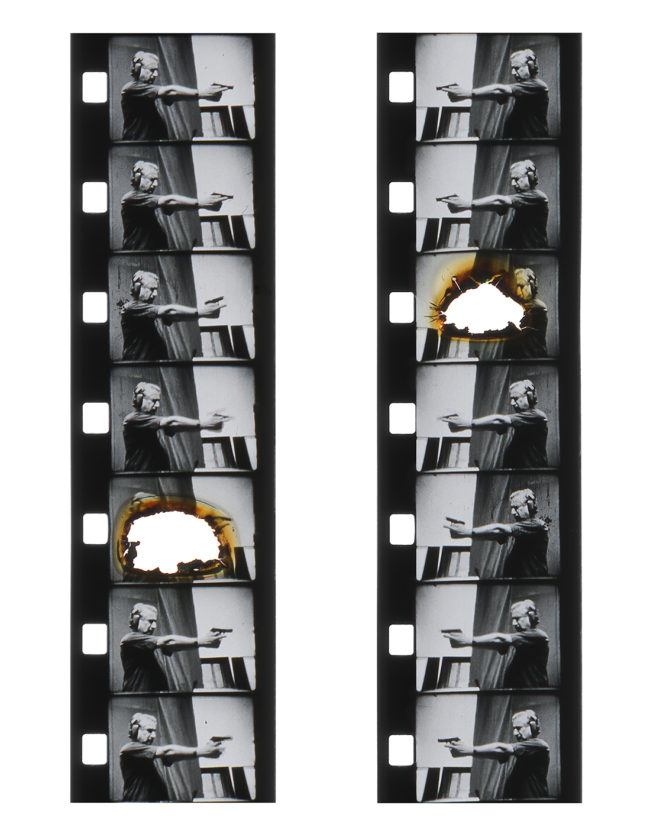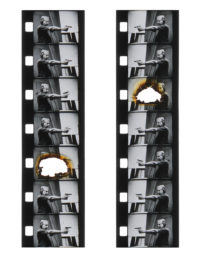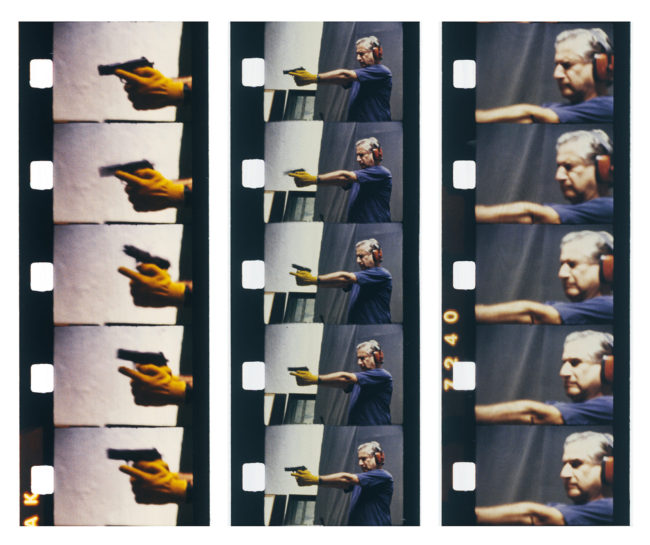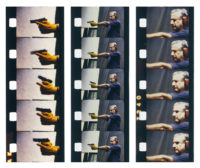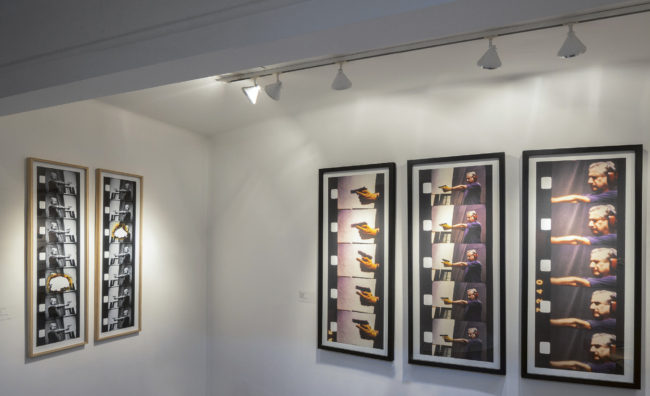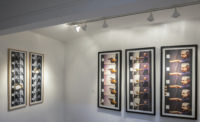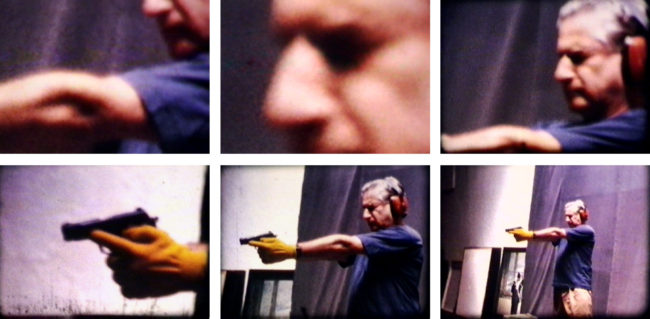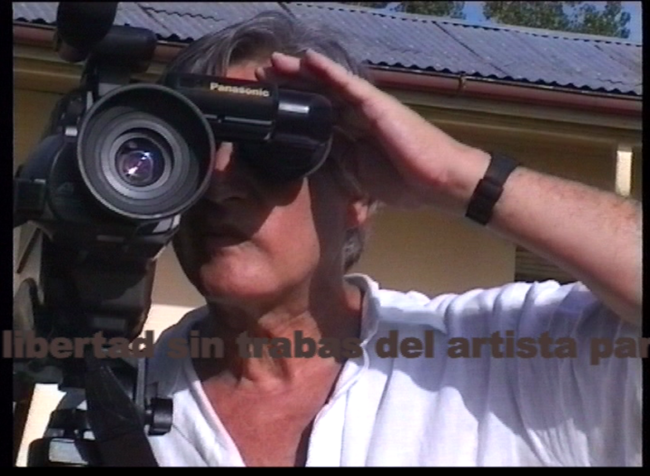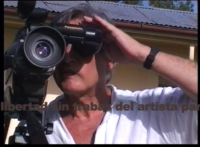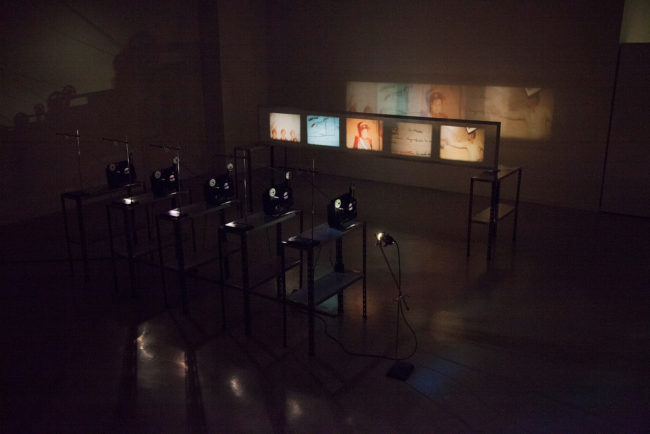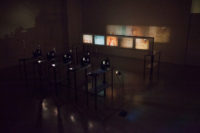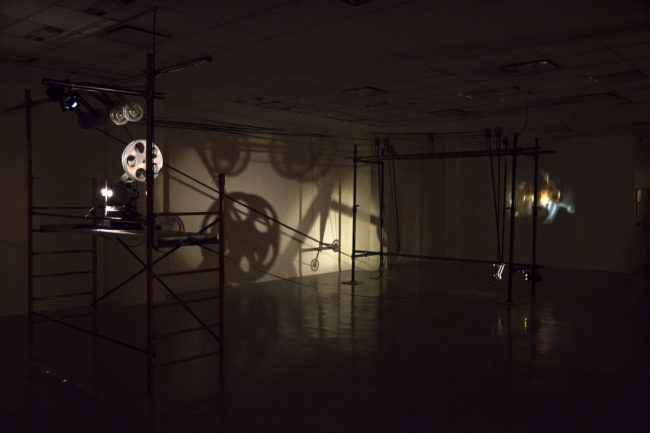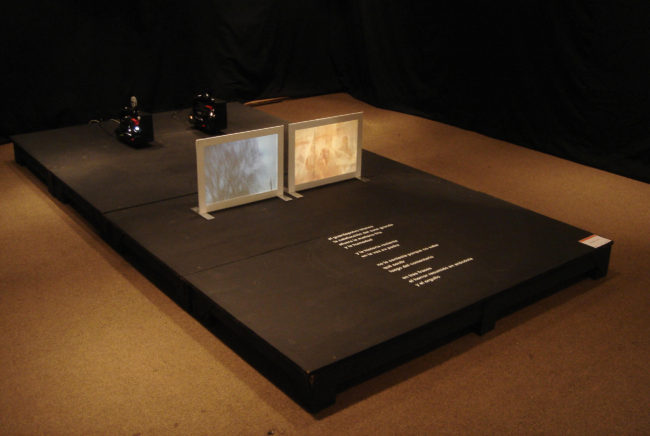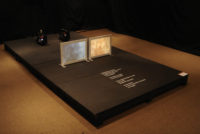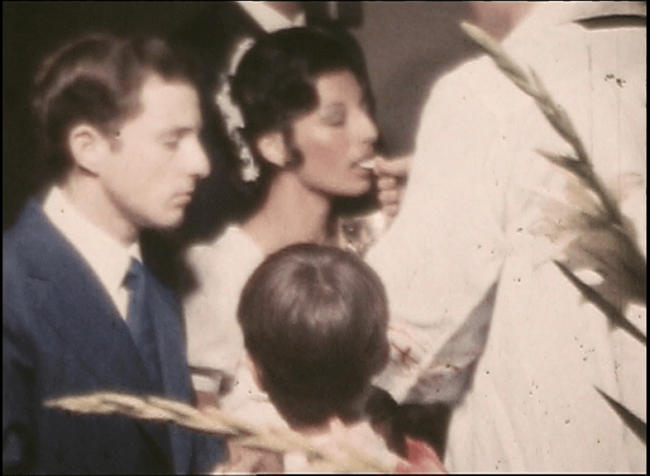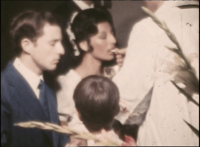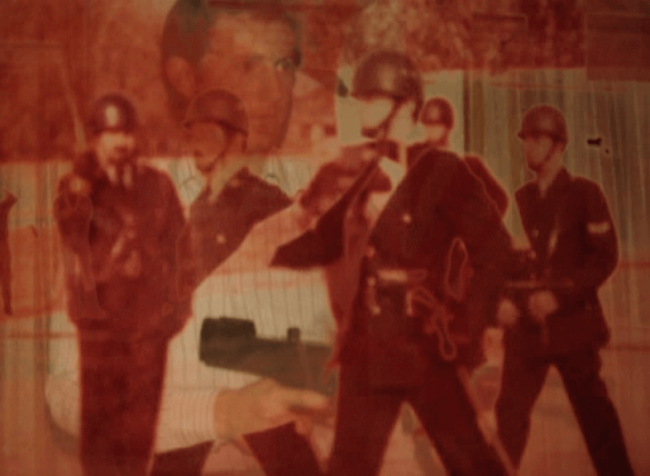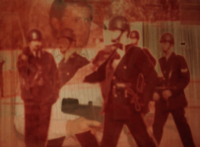I
En el catálogo que acompaña la muestra Cine de exposición, el curador Jorge La Ferla explica que esta exhibición de las “esculturas fílmicas” de Denegri tiene lugar en un momento en que “la materialidad original del cine está llegando a su fin, mientras que la circulación de las imágenes fílmicas se expande vertiginosamente fuera de las salas cinematográficas”. En efecto, estas obras tensionan de una manera novedosa el vínculo entre las películas y las salas de exposición: investigan sobre las posibles formas de diálogo, exploran el modo en que desbordan mutuamente unas sobre otras y aprovechan sus puntos de conflicto.
La muestra está organizada sobre dos ejes alrededor de los cuales se distribuyen las obras. Por un lado, la serie Éramos esperados que alude a la Historia nacional y, por otro lado, el grupo de obras que trabajan a partir de la memoria familiar. En la serie histórica: Éramos esperados (Super 8), 2012; Éramos esperados (16 mm), 2013; Éramos esperados (hierro y tierra), 2013; Éramos esperados (plomo y palo), 2013 y Éramos esperados (Sísifo), 2013. En la serie familiar: Un martes, 2006; Día uno, 2007 y Grito, 2013. Estos dos vectores se intersectan, porque –en la mirada de Denegri– la autobiografía no es más que una sinécdoque de la historia de la nación. Memoria individual y memoria colectiva: la institución familiar funciona sobre el mismo imaginario disciplinario y represivo que las instituciones del Estado.
En Éramos esperados (Super 8), la primera obra de la serie histórica, dos proyectores enfrentados exhiben, sobre la misma tela, las imágenes de Obreros saliendo de la fábrica (uno de los célebres films Lumière que señalan el comienzo del cine, 1895) y una reconstrucción o recreación de La bandera argentina (de Eugène Py, considerada la primera película argentina, hoy perdida, 1987). Éramos esperados (16 mm) repite el procedimiento pero a gran escala: ahora los aparatos están más separados y las películas recorren la distancia entre ambos antes de volver a ingresar en ellos para ser proyectadas y mezcladas. La tercera pieza de este conjunto, Éramos esperados (hierro y tierra), modifica el dispositivo: se trata de tres proyectores, alineados en paralelo, uno al lado del otro, que disparan sus imágenes sobre una misma pantalla. En el centro, nuevamente, La bandera argentina y, a sus costados, imágenes de conflictos obreros ocurridos a comienzos del siglo XX (la rebelión agraria conocida como El Grito de Alcorta y la huelga obrera de La Semana Trágica). En la instalación Éramos esperados (plomo y palo) es la propia película la que compone una pantalla –formada por tiras de celuloide que suben y bajan entre dos travesaños– donde se proyectan las imágenes que salen del aparato: breves escenas de represión (los golpes y los disparos) a cargo de la Policía o el Ejército en diversas movilizaciones sociales. Por último, en Éramos esperados (Sísifo), un proyector de Super 8, apoyado sobre el piso y muy cerca de la pared, alumbra su pequeño rectángulo sobre el rincón más alejado de la sala de exposición. La película se eleva y desciende para ingresar al proyector y lanzar sobre la pared sus imágenes: la bandera argentina izada hasta el extremo de un mástil y reemplazada por escenas del terrible bombardeo en Plaza de Mayo (1955). Ese movimiento interminable de ascenso y derrumbe configura una síntesis de la historia de la nación.
Denegri afirma que la serie Éramos esperados se despliega sobre un terreno “que tiene como eje las perspectivas políticas de la Argentina del siglo XX. El título ocupa el lugar de un llamado de atención, apunta a una responsabilidad del presente frente al pasado. Fue tomado de Walter Benjamin: ‘El pasado lleva consigo un índice secreto y a través de él remite a la redención. ¿No nos roza, entonces, el aire que estuvo entre nuestros antepasados? ¿Acaso en las voces que escuchamos no resuena el eco de otras que enmudecieron? ¿Y las mujeres que hoy cortejamos no tienen hermanas que no pudieron conocer? De ser así, hay un acuerdo secreto entre las generaciones pasadas y la nuestra. Éramos esperados, entonces, sobre la tierra. Al igual que a cada generación anterior a la nuestra, nos fue otorgada una débil fuerza mesiánica, de la cual el pasado exige sus derechos’”. ¿Cuál es ese “acuerdo secreto” que las instalaciones de Denegri ponen en escena? ¿Y qué es lo que el pasado reclama del presente? La serie histórica abre una nueva dimensión en la trayectoria de Denegri que –como él mismo dice– suele trabajar a partir de “registros directos de lo cotidiano para producir obras que reflexionan sobre lo íntimo y lo autobiográfico”. Lo autobiográfico se ha contaminado con lo histórico, en Cine de exposición, y la vida de la patria reverbera en cada instante de la vida privada. En las home movies, todas las familias parecen felices; pero en las instalaciones que conforman la serie familiar, Denegri deconstruye el archivo íntimo para insinuar las cicatrices que la historia política ha dejado sobre los cuerpos.
En Un martes, dos proyectores en paralelo disparan sus imágenes sobre sendas pantallas translúcidas: en una de ellas se ve una rápida sucesión de imágenes del archivo familiar (un niño disfrazado y con armas de juguete, un hombre vestido de policía y con armas de verdad), en la otra se ve un lento recorrido que muestra las copas de los árboles. La luz que atraviesa las pantallas ilumina un texto que remite a los años de la dictadura militar: “La historia reciente / en la voz de su padre // No le contesta / porque no entiende / qué sentir”. Día uno dispone cinco proyectores en paralelo que organizan un singular álbum de fotos familiares. En el centro, imágenes de un niño en la escuela o disfrazado con traje de granadero; a ambos lados, imágenes de cuadernos escolares; en un extremo, la madre maestra; en el otro extremo, el padre policía. El conjunto funciona como un autorretrato de infancia enmarcado por la obediencia y la represión en un continuo que atraviesa a la familia, la escuela y la sociedad. Por último, en Grito (instalación), la película que sale de un proyector de 35 mm despliega un loop zigzagueante e imprime sobre la pared una secuencia de recuerdos autobiográficos: “Imágenes que retumban en la cabeza y palabras que se atoran en la garganta. Filmaciones en Super 8 son revisadas por una mirada que intenta echar luz al paradójico vínculo entre los afectos y la ideología, en un clima de alegría infantil, intimidad familiar y terrorismo de Estado”.
II
Hay dos imágenes que constituyen los componentes básicos de Éramos esperados (Súper 8), la pieza que dio origen a esa serie de instalaciones, y que –de alguna manera– enmarcan al resto de los trabajos en esta exposición. Se trata de dos imágenes fundacionales: la salida de los obreros de la fábrica y la bandera argentina flameando sobre el firmamento. Tiene sentido sobreimprimir estas imágenes para mostrarlas juntas: el film de Py es un testimonio del temprano interés que despertó en la Argentina el invento de los Lumière. En Buenos Aires, las primeras proyecciones tuvieron lugar apenas unos meses después de la primera función en el Boulevard de Capucines. A comienzos del siglo XX, más de la mitad de la población de la ciudad estaba compuesta por inmigrantes; muchos de ellos no hablaban castellano y la mayoría eran pobres y analfabetos. ¿Qué podía hacer, en sus escasos momentos de ocio, un extranjero que no dominaba la lengua y que no podía pagar una entrada de teatro? El cine se convirtió en un entretenimiento popular porque era un espectáculo que resultaba accesible para cualquiera.
En 2 x 50 años de cine francés, Godard explica que el centenario de la primera función pública de los Lumière en el Grand Café no conmemora la invención del cine la sino fecha en que, por primera vez, la gente pagó tres francos para ver imágenes proyectadas sobre una pared. Es decir, no las imágenes en movimiento (puesto que había distintas modalidades de imágenes en movimiento antes de los Lumière) sino cierta forma de verlas: un circuito comercial de exhibición basado en la proyección de imágenes sobre una pantalla, en una sala oscura, ante un grupo de espectadores sentados. En Cine de exposición hay otro comienzo. Empezar –anota Said– es producir una diferencia. En este sentido, todo comienzo es una forma de respuesta. Todo comienzo, podría decirse, empieza antes de sí mismo. Frente a la idea de un origen absoluto, Said se afirma en la idea nietzscheana de un comienzo: no una continuidad que se despliega en el tiempo sino una elaboración activa, que expande o refuta, pero siempre transforma. Comenzar implica una discontinuidad, una declaración de intenciones que, de algún modo, apunta hacia aquello de lo que pretende separarse así como anticipa su propio desarrollo. Denegri muestra cuál es su respuesta. O su refutación. Parte del film de los Lumière, pero le da otro uso. Como si ensayara de qué otro modo pueden aprovecharse esas imágenes en movimiento.
En primer lugar, hay aquí otro comienzo para el cine. Ya no una ventana abierta o un espejo que transparenta el mundo: en estas instalaciones, las imágenes del cine son imágenes en su más plena materialidad. No son reflejo perfecto sino cuerpo imperfecto. Una materia opaca que es esculpida o procesada en la proyección (en un loop que se repite y que corre a la vista de los espectadores, que se combina con otras imágenes, que adopta la textura de la superficie sobre la que se imprime). Si es cierto que los primeros espectadores se asustaban cuando veían que el tren se aproximaba a la estación, aquí, en cambio, Denegri hace todo por desmontar la ilusión óptica y por poner de manifiesto el soporte que hace posible el truco. No sólo vemos la proyección y el proyector sino que, además, vemos los dibujos caprichosos que forma la película cuando atraviesa la sala y vemos el celuloide que se va deteriorando inevitablemente a medida que pasan los días de la exposición. A Denegri le interesa el soporte más que la imagen. El celuloide más que el cuadro. El cine –parecería decir– no es una sucesión de fotogramas; es el celuloide cuando resulta martirizado por un proyector para lanzar sus restos sobre una pantalla.
En segundo lugar, las instalaciones de Denegri imponen un cambio en la relación de las imágenes con el espectador. Más que proyectados, los films están aquí desplegados, “expandidos”. Porque las obras no funcionan de manera frontal sino multidimensional, para espectadores dispersos que establecen su propio tiempo de visión de manera ambulatoria. De hecho, el espacio de exhibición ya no es tanto un entorno al que habría que sustraerse para que la película ocurra sino, más bien, el sitio ineludiblemente material donde estamos obligados a apreciar el dispositivo fílmico. El dispositivo fílmico, es decir: la proyección, la cinta de celuloide y el aparato mecánico. Estas instalaciones no intentan hacernos olvidar el andamiaje tecnológico que sostiene la ilusión de un mundo virtual puesto en movimiento ante nuestros ojos sino que, al contrario, sólo funcionan a condición de que reconozcamos todas las dimensiones del acontecimiento: vemos la película proyectada, así como vemos el proyector; vemos las imágenes en movimiento así como vemos el celuloide sobre el que están impresas; vemos el film sobre una pared de la sala, así como vemos la sombra del aparato en el muro aledaño.
Y en tercer lugar, la muestra de Denegri también hace que se modifique el espacio de exposición: lo obliga a abrirse para dar cabida a estos artefactos fílmicos. Ya no se trata de explorar qué puede hacer el cine por los museos, sino más bien ¿qué deberían (qué pueden) hacer los museos con el cine? ¿Cómo exhibir películas en un espacio tradicionalmente reservado para las artes visuales? Benjamin sostenía que se había perdido mucho tiempo discutiendo si la fotografía y el cine eran arte cuando, en realidad, lo que se debía debatir era en qué medida el surgimiento de la fotografía y del cine habían transformado radicalmente el concepto de arte. Denegri piensa lo mismo: de qué modo la escena del arte debe hacer uso del cine, no para neutralizar toda su originalidad dentro de los protocolos tradicionales sino, al contrario, para hacer que su presencia desborde sobre el modo en que asistimos a una obra artística. Es cierto que las piezas de Denegri son “esculturas fílmicas”; pero habría que agregar que se trata de esculturas con volúmenes singulares. Son volúmenes informes, sin marco, sin borde. ¿Se los rodea o se los atraviesa? ¿Se puede pasar por entre los loops de celuloide que surcan la sala? ¿El espacio entre el proyector y la pantalla forma parte de la obra?
III
En algún momento de Histoire(s) du cinéma, Godard explica: “En 1932 el holandés Jean Ort estudia las estrellas / que se desvían de la vía láctea / pronto, como estaba previsto, la gravedad las devuelve a su lugar / estudiando las posiciones / y la velocidad de esas estrellas repatriadas / Ort pudo calcular la masa de nuestra galaxia / imaginemos su sorpresa / al descubrir que la materia visible no representaba más que el cincuenta por ciento de la masa necesaria para el despliegue / de una fuerza de gravedad semejante / adónde se había ido entonces la otra mitad del universo / la materia oscura había nacido / omnipresente / pero invisible”. El cine de Godard siempre ha estado obsesionado por iluminar el reverso de todo discurso que impone autoritariamente su dominio. Puesto que no hay hegemonía sin exclusión de la disidencia, el trabajo del cineasta consiste en reponer aquello que el cine dominante necesita borrar para consolidarse. Se trata, en efecto, de forzar los materiales para denunciar que esa supuesta totalidad es incompleta y encontrar la materia oscura que se ha extraviado en el camino. Godard no es el único que ha trabajado a contrapelo aunque, sin duda, es el que lo ha hecho de la manera más enfática. En Cine de exposición, Denegri avanza por ese mismo camino pero en su sentido más puramente material y técnico. ¿Qué hay del otro lado de toda película?
Los loops, el celuloide, los formatos diversos (Super-8, 16 mm, 35 mm), el andamiaje de cada obra o el proyector constituyen un momento tan fundamental de esta exposición como la vista de imágenes sobre una superficie. Tanto o más fundamental. Para decirlo de otro modo: la obra consiste en la proyección más el proyector. No el efecto cine simulado a partir de la tecnología digital sino la película detrás de la proyección, el dispositivo detrás del efecto, el soporte material detrás de la ilusión. Como decía Raymond Bellour a propósito de Tierry Kuntzel: “¿Cómo hacer visible el film debajo del film, el film-película oculto detrás del film-proyectado?” Este procedimiento aparece espectacularizado en Éramos esperados (plomo y palo), donde la imagen que emite el proyector se despliega sobre una pantalla formada por el mismo celuloide que entra y sale del aparato. El trazo del film se inscribe sobre su propio celuloide. Es decir que la larga tira de fotogramas genera “la pantalla sobre la que impacta la imagen que surge del proyector. Así, la película se proyecta sobre película. O bien, las acciones se forman sobre una superficie generada por el mismo celuloide que las contiene. Lo que vemos como imagen proyectada es el resultado de lo que se desarrolla por debajo de ésta, del fotograma físico y de la mecánica que lo arrastra”. Éramos esperados (plomo y palo) es, quizás, la obra más extrema de la muestra; pero el mismo principio subyace al resto de las obras: la proyección no convalida una ilusión referencial sino que, al contrario, hace lo posible por atacar su unicidad. Uno es dos. Proyectar, para Denegri, implica descentrar, desagregar, desdoblar. Sobreimprimir. Cualquier imagen puede ser interpelada por otra imagen. De hecho, la mayoría de estas instalaciones usan más de un proyector y trabajan sobre el cruce de imágenes heterogéneas, casi como una puesta en acto de las teorías de Eisenstein sobre el montaje de atracciones. Allí –ya se sabe– el contacto entre dos imágenes supone un conflicto, una tensión dialéctica que se resuelve como revelación emocional de un concepto.
Al ser cruzadas con otras proyecciones, las imágenes dejan de funcionar como un mero reflejo y se revelan como una superficie legible. Revelan, por así decir, su carácter intertextual. No vemos una cosa en la pantalla sino que leemos un sentido que se construye en ese cruce visual. Lo que dice la proyección es el resultado de un diálogo. En contacto con otras imágenes, cada imagen recuerda lo que parecía haber olvidado. Es lo que Benjamin llamaba el “inconsciente óptico”. En efecto, eso que las imágenes traen a la luz es lo que habían ocultado. Y ese pasado reprimido (en el sentido psicológico) es también, para Denegri, un pasado de represión (en el sentido político). En el film de los Lumière, lo que no vemos cuando los obreros salen de la fábrica es –justamente– lo que ha sucedido en el interior durante el día de trabajo. Lo que no vemos es el trabajo. Y, sobre todo: no vemos las condiciones de explotación del trabajo en la fábrica. Se trata de la fábrica de materiales fotográficos propiedad de Antoine Lumière, padre de los célebres inventores y rico industrial de Lyon. La industria de la fotografía y del cine, ya lo sabemos, es una forma moderna de la acumulación de riqueza. Por eso no es casual que Eugène Py eligiera una bandera argentina como tema para la primera película en la historia de la nación: ése era el emblema de un país moderno. O, al menos, de un país que quería asomarse a la modernidad. Py había llegado al país atraído por su espíritu cosmopolita. No fue el único: a fines del siglo XIX y comienzos del XX, muchos inmigrantes pobres se afincaron en Buenos Aires y trajeron consigo el virus del socialismo y el anarquismo. El sueño moderno era, también y sobre todo, un sueño de prosperidad industrial; pero no hay industria sin obreros, y los obreros siempre resultan conflictivos porque, tarde o temprano, comienzan con sus reclamos laborales.
Eso es lo que muestra Denegri transparentándose sobre la bandera argentina en la serie Éramos esperados: imágenes de El grito de Alcorta (1912), de La Semana Trágica (1919) y de diversos enfrentamientos obreros con las fuerzas del orden a lo largo del siglo XX. Se podría preguntar: ¿cuál es el fuera de campo en el film de los Lumière?, ¿qué hacen los obreros cuando salen de la fábrica? Ahora lo sabemos. Cuando salen de la fábrica, los obreros van a protestar. Van a protestar por las condiciones de explotación que sufren en las fábricas. Van a protestar y son reprimidos por la policía. Por la policía que defiende los intereses de los dueños de las fábricas, como el padre de los hermanos Lumière. Denegri actúa como un medium: convoca esa dimensión espectral de las imágenes que todo plano cinematográfico oculta bajo el peso de lo visible. En realidad siempre fue así. Desde el comienzo. Lo supieron tempranamente las fotografías de espíritus, tan populares a mediados del siglo XIX y comienzos del XX, gracias a los trabajos de Mumler y de Hope, entre otros. E incluso antes, entre el siglo XVIII y el siglo XIX, gracias los espectáculos de fantasmagorías de Paul Philidor y de Étienne Robertson (a mitad de camino entre la representación teatral y el show de ilusionismo), que ponían en escena relatos góticos apoyados en trucos y efectos especiales. “La fantasmagoría –dice Adorno– surge cuando, bajo la restricción de sus propias limitaciones, los más novedosos productos de la modernidad se acercan a lo arcaico. Cada paso hacia adelante es, al mismo tiempo, un paso hacia el pasado remoto”.
Cuando Gorki asiste a una función de las “fotografías animadas” de los Lumière, lo que le llama la atención no es su capacidad para reproducir el movimiento; más bien, se inquieta como si estuviera viendo un desfile de almas en pena. Desde esa perspectiva, las películas parecen hacer hechicería con las cosas reteniendo de ellas sólo una corteza exangüe. El cine no es, para él, un artefacto que permite recrear la vida (el biógrafo) sino un espejo maléfico donde cada momento cotidiano puede convertirse en un pequeño infierno. Luego, esa sensación será olvidada y los espectadores se acostumbrarán a ver las imágenes como si se tratase de una ventana abierta al mundo; pero en 1896, un espectador sensible como Gorki aún podía afligirse pensando que los films eran el producto de una profanación y un saqueo. De alguna manera, las instalaciones de Cine de exposición traen esa violencia obturada u olvidada hasta nuestro presente: la sobreimprimen sobre esas otras imágenes –las plácidas imágenes conocidas de la historia del cine– y transforman el espacio de la muestra en una sesión de espiritismo. Se me dirá que no hay que ser tan ingenuo sobre qué puede una imagen. Aun cuando se piense que una imagen vale más que mil palabras, indefectiblemente habría que aceptar que ni siquiera mil imágenes pueden reponer un cuerpo. A pesar de lo que Edison o Demeny o Bazin pudieran fantasear, el cine no nos devuelve a las personas. Y por supuesto que estas instalaciones fílmicas de Denegri producen, fatalmente, imágenes. No cuerpos, sino imágenes de cuerpos.
Pero –como afirma Didi Huberman– la mirada siempre quisiera ser una acción tallada sobre lo tangible: vemos porque no podemos tocar. Mientras yo observaba las obras de Denegri sucedió que uno de los proyectores comenzó a funcionar mal y la película se desenganchó: los fotogramas dejaron de ser arrastrados de manera metódica por el mecanismo del aparato y empezaron a pasar a gran velocidad de modo que, sobre la pantalla, ya no se veían hombres y mujeres en movimiento continuo sino una serie de líneas verticales borroneadas que atravesaban el cuadro vertiginosamente de arriba hacia abajo. El desperfecto no era un error sino que formaba parte del horizonte de posibilidades de la muestra. No porque Denegri planeara destruir el celuloide sino, más bien, porque sabía que eso tenía que suceder indefectiblemente. De ese modo, el deterioro de las obras pasa a formar parte de las obras (que incorporan las marcas dejadas por el trabajo de proyección continua): el desgaste natural de los materiales –azaroso aunque no imprevisto– es una consecuencia del funcionamiento intensivo pero, ante todo, imprime una dinámica particular al conjunto. Aun así, cuando me tocó asistir a ese pequeño cataclismo, fue doloroso sentir (no sólo ver) cómo las ruedas dentadas y los engranajes del proyector lastimaban el celuloide. Me quedé ahí, observando, sin animarme a intervenir, y sólo logré recomponerme cuando uno de los cuidadores de sala detuvo la proyección.
Entiendo que esa sensación punzante (tan indudable como incontrolable) que experimenté como espectador integra de pleno derecho el momento de la creación. Pero no en un sentido convencional –como reacción ante propuesta determinada estética que se abre para ser completada por el observador– sino, más bien, porque la obra nos necesita para constituirse en tanto obra. No correspondencia apartar la vista porque, estas instalaciones son frágiles, precarias, inestables, efímeras: precisan de nuestra mirada. Debemos estar ahí para velar por ellas y, también, para sufrir con ellas. Entonces quisiera argumentar que, si bien las imágenes no pueden hacer otra cosa que evocar la violencia sobre los cuerpos, las obras de Denegri consiguen solidarizarse con esos pesares. Y tal vez, allí –como diría Benjamin–, el cine alcance alguna forma de redención.


